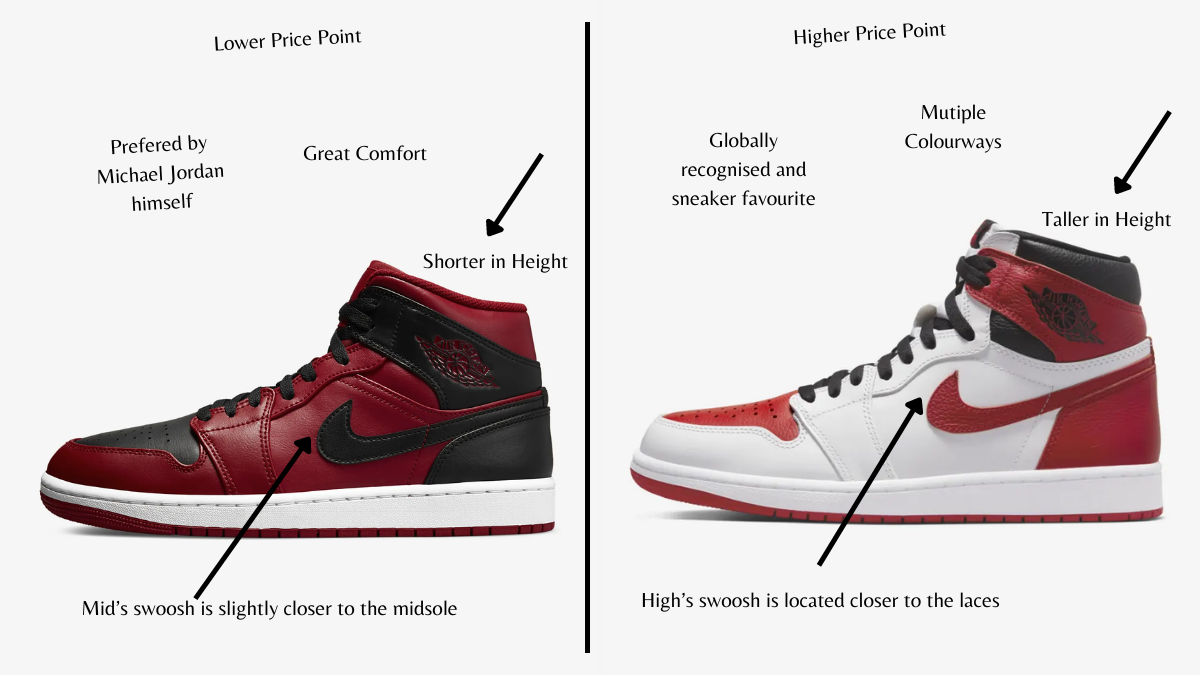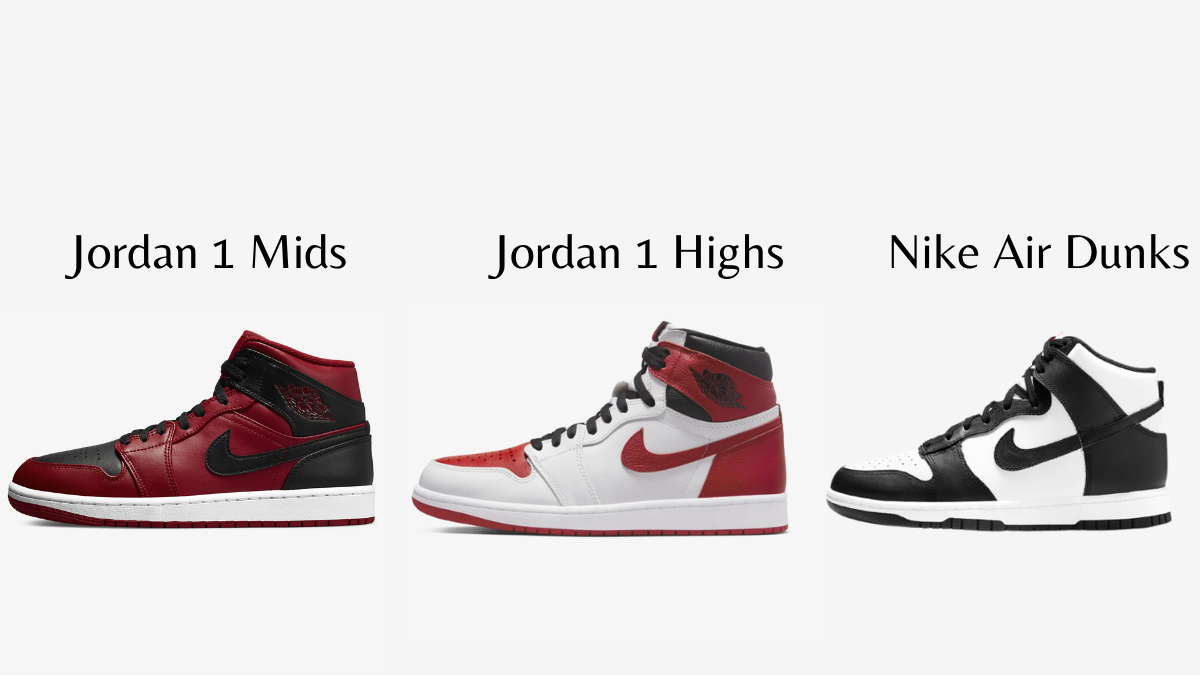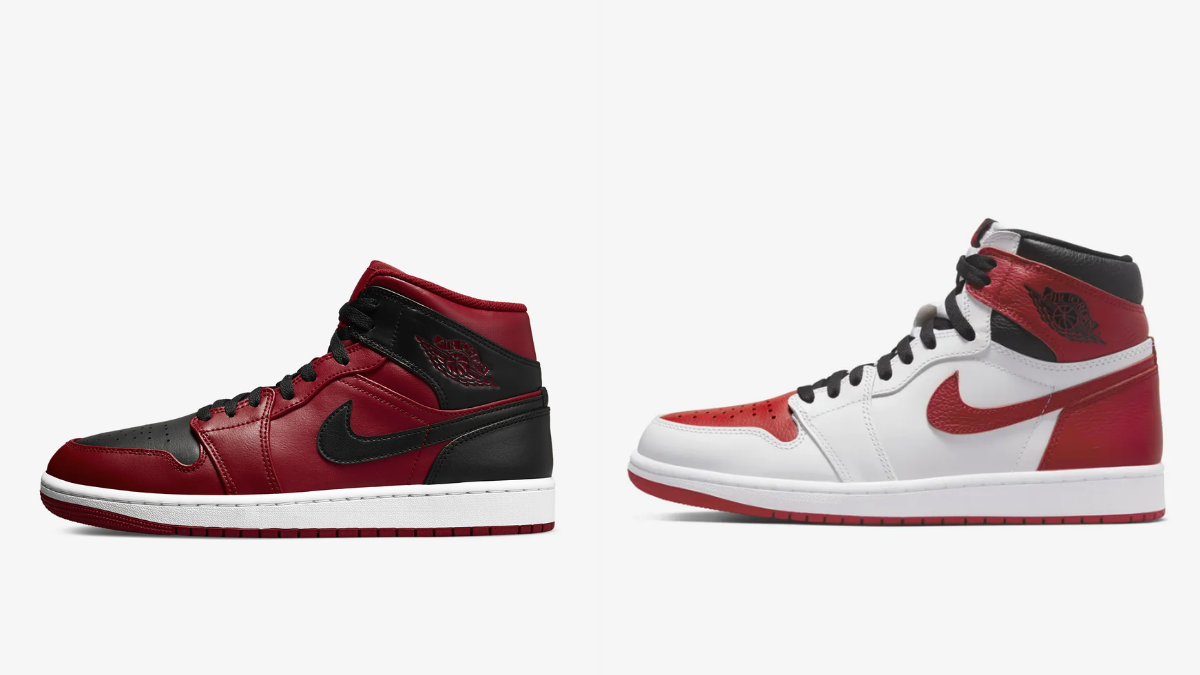The Jordan 1 Mids vs High story is one that defies logic. Ever since it came out in 1985, the Air Jordan 1 High Top sneaker became one of the most popular 80s sneakers on the market. The fame it gained throughout the rising popularity of Michael Jordan still persists, even though the silhouette of the sneakers remains the same.
It’s now available in a wide range of color variations, and of course, there were attempts to recreate it in other variants. One of Nike’s notable models imitating Air Jordan High 1 was, in fact, Air Jordan Mid 1.
Unlike its predecessor, this model didn’t really catch on. Here you’ll learn the difference between Jordan 1 Mids, Jordan 1 Highs, and Dunk Highs and what made some of these models more popular than others. Sit back and enjoy some Nike history as we look at Jordan 1 Mids vs High.
Jordan 1 Mids vs High (What’s the difference)

At a first glance, there doesn’t seem to be much difference between these two models, except for added ankle support in the Highs, of course. They both have the signature swoosh, the compressed air pockets, and come in many colorful variants. However, at a close look, you can discover some clear distinctions between Jordan Mids and Highs. The first one is the price.
While some not-so-popular Highs have a similar reselling value to the Mids, in most cases, the former is in a much higher price range. So, if you want to get the authentic Jordan 1 High look and feel, you will need to reach deeper into your pocket.
Given that both the quality and the quantity of the material used in Highs is higher, this makes sense. Mids are essentially designed as the low-budget alternatives for the Highs and this is more than evident in the thickness of their material and padding solutions. The rich history also adds to the price factor.
Surprisingly, when it comes to comfort, Mids are way ahead of Highs, although this may come down to personal preferences. However, many sneakerheads claim that mids offer just as much lateral stability as the Highs do but due to their lower cut, they seem to be less constricting at the collar.
This statement was also supported by Michael Jordan, which was the reason behind creating the Mids. Not only that, but this same feature makes the lower cut model much easier to put on and off. According to the measured performance on the court, there isn’t any difference in the sole comfort levels.
There are also some aesthetical differences. The High’s swoosh is located closer to the laces. Whereas the Mid’s swoosh is slightly closer to the midsole. The Mids have eight laces holes, and given their cut, the Highs have an additional one where the sneaker joins the ankle.
Why the Mid Jordan 1 Didn’t Catch on
There are many reasons the Mid Jordan 1 wasn’t received with the same enthusiasm as its predecessor, nor did it achieve such fame. For one, its release came too late. Michael Jordan had long expressed that he would like the Highs baring this name to have a Mid variant. But by the time it happened, he wasn’t there to drive up the hype as he did with the Jordan 1 High, or like many other famous icons did in the sneaker world. Without this, there was no way to get people hooked on collecting this model.
Since fewer interested people were buying it in the first place, Mid Jordan 1 had a much lower reselling value. Until this day, these sneakers rarely sell out quickly after release, so there is no need to overpay for them.
Besides, without the hype, the history, and the celebrity collaborations behind it, resellers will never invest in a sneaker anyway. This was certainly the case with Jordan 1 Mids. They were almost identical to the Jordan 1 Highs, except without all the legendary history the latter has.
Another reason collectors often choose to pass on the Mids is the quality of the material. Unlike the Highs, which are made from premium grade leather, the Mids are typically assembled from a combination of low-grade leather, nubuck, suede, and sometimes even nylon and other synthetic materials.
All of these elements coming together made the sneaker community disappointed with Air Jordan 1 Mid right after it emerged. The fact that this happened when the use of the internet became popular had only made things worse. Now that the sneaker communities have taken over social media, the disapproval can spread faster than ever.
Many celebs see a profit in endorsing or advertising trending sportswear. Since Air Jordan Mids 1 aren’t exactly trendy, the celebrities won’t be interested in these sneakers either, often causing their followers to shy away from this model. Some big names would even go as far as to speak badly about this model in order to advertise the one they have an endorsement for. They use the mainstream media to share their message and, not wanting to be marginalized by their own culture, sneakerheads follow suit.
Jordan 1 Mids vs High vs Nike Dunk

If we compare both Jordan 1 models to the Nike Dunk High, which came out at the exact time Jordan 1 High did, things become even more interesting. For all intents and purposes, Dunk represents a middle ground between the Jordan 1s. At the same time, it has so many differences separating it from these models.
For starters, despite enjoying just as long history as the Highs, Dunk never had the same cultural impact as it was never endorsed by a celebrity of such magnitude as Michael Jordan. For the same reason, the price of the Dunk was way below the Highs and even the Mids when those came out. However, in recent years, their popularity has suddenly started to increase, driving up their reselling value to the level of the Highs.
Another reason some Dunk models have higher values lies in the variations of the materials used in their production. Some use thin leather like the Mids, while others are made from thick leather with a thin plastic covering, similarly to the Highs. Dunks are said to be just as comfortable as Mids are, despite some drastic differences in the sole.
Unlike the Jordans, the Dunk High has much thicker padding, except on the tongue of the shoe. This also supports the theory that these are designed to be comfortable and easy-to-handle sneakers. Dunks also lack the compressed air pocket in their heel, something the Jordan 1 is well known for.
Besides the lack of celebrity hype, another huge reason why Dunks weren’t so popular initially is that they look different. While they also use the hallmark Nike Swoosh, it’s usually colored the same as the primary color of the sneaker. Meanwhile, both Jordan 1s feature a swoosh in a color that creates a striking contrast to the shoe. They also have the wings logo on the outside of the flap. As opposed to the Dunk, which has a loop and riding at the back.
The Jordans 1s feature a separate heel cap and top, which requires users to lace them all the way up. The Dunk allows you to skip lacing the ankle section and leave them hanging off the sides. Its midsole has a few bumpy areas at the flex point, while the midsoles of the Mids and the Highs have less texture to them.
History of the Jordan 1
Nike’s Air Jordan 1 was created by Peter Moore in 1985, only one year after the soon-to-be star basketball player Michael Jordan signed for the Chicago Bulls. This also earned him a very lucrative sponsorship deal with Nike, although he wasn’t familiar with the brand yet. The Jordan 1 highlights Nike’s signature court features, such as an overlay on the toe, the air pocket in the heel, and the reinforced ankle support thanks to the high cut.
Despite lacking today’s technology and Michael Jordan himself saying that he prefers mid-cut models, the public seemed to be thrilled with Jordan 1 High. Not only that, but at the time, the black, red, and white models violated court uniform policy, for which Jordan was fined several times. The fines were paid by Nike as they generated even more publicity and revenue for the company.
To cater to a wider audience (and Michael Jordan himself), in 2001, Nike released the Mid variation of the Jordan 1. Unfortunately, by then, the basketball star was already over his peak. This caused their popularity to decline and the shoes to have a lukewarm reception.
Conclusion
Despite being a less expensive novelty, and often praised for its added comfort, Jordan 1 Mids couldn’t live up to expectations raised by the Jordan 1 High fans. When it comes to Jordan 1 Mids vs High, even Michael Jordan expressing his preferences over the lower cut couldn’t sway the public in this direction.
Not only that but when a third model, the Nike Dunk High hit the market, it was received with far more enthusiasm than the Mids. Offering a different type of comfort and even more color variations, the Dunk has now almost reached the Jordan 1 High’s reselling value and had a similar cultural impact.
To stay updated on everything happening in men’s style/lifestyle, street culture & music follow @heartafact on Instagram

